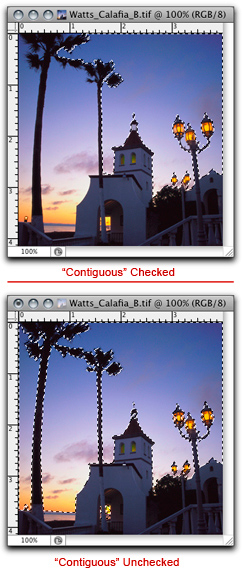Layer Masks can be one of the tougher concepts of Photoshop to wrap your brain around,
but once you understand the basics, anything is possible! This will take more than one Photoshop technique article, so we’ll break this up into multiple articles over the next several months.
Here are the links to each:
The Power of Layer Masks in Photoshop: Part 1 – Layer Masks and Adjustment Layers
The Power of Layer Masks in Photoshop: Part 2 – Layers Panel
The Power of Layer Masks in Photoshop: Part 3 – Tools and Techniques
The Power of Layer Masks in Photoshop: Part 5 – The Brush and Lasso Tools
Read on, and discover one of the most powerful photo editing features.

The Magic Wand Tool
Purpose:
The Magic Wand Tool is used to make a selection. It works best when the colors or brightness in the selection area are fairly similar, consistent, and sharply delineated from the areas you don’t want to select, such as a blue sky against a horizon, or a yellow flower against a green background. This tool works best with “Strategy 1” (See Part 3).
Where to Find:
You can find the Magic Wand Tool in the Tools Panel, or by pressing its Speed Key, which is “W”.
How It Works:
1. Choose the Magic Wand Tool from the Tools Panel, or by using the Speed Key “W”.
2. Choose your desired options in the Options Bar.
3. Click in the desired area to be selected, more than once if necessary (with the “Add to Existing Selection”button toggled on), until the “Marching Ants” define the area that you want to select.
4. Choose the desired Adjustment Layer(s) to make your correction(s). The “Marching Ants” will disappear so that you can see the effects of your adjustments unimpeded.
What’s in the Options Bar?

“Tolerance”: A Low Tolerance Value will select pixels similar to the ones you click: a High Tolerance Value will select pixels with a larger range of colors. Enter the value in pixels, ranging from zero to 255. Once a value is entered, change the value by using the arrow keys. A suggested starting value is 20 to 30.
“Anti-Alias”: This will help create a smoother edge to your selection. It is best to leave this checked.
“Contiguous”: If this box is checked, then only adjacent pixels within the tolerance range are selected (locally). If this box is unchecked, all pixels in the tolerance range are selected throughout your image (globally).

Images and screen shots:
© 2011 John Watts. All Rights Reserved.
This can be confusing, but here’s a good visual example to the right.
The top image shows the effects of using the Magic Wand with “Contiguous” checked. Think “Local Selection”: By clicking a few times in the sky area to the right of the palm tree (with the tolerance set at 30), all pixels in the blue color range are selected, except the ones to the left of the palm tree, because the palm tree does not fit within the tolerance selected (it is too black and dark) and blocks the selection from going any further.
The bottom image shows the effects of using the Magic Wand with “Contiguous” unchecked. Think “Global Selection”: By again clicking a few times in the sky area to the right, all pixels in the blue color range are selected, including the ones to the left of both palm trees, as well as the small areas in the detail of the palm trees and the building arch. All of this was accomplished by a few clicks in the right-hand sky area only, and a few clicks in the reddish area of the sunset, saving yourself quite a bit of time and frustration.
“Add a New Selection” / “Add to Existing Selection” / “Subtract from Existing Selection”
It would be a rare situation to be able to make a selection by clicking in your desired area just once, so an understanding of these buttons is very important and you’ll find the same buttons and choices in most Selection Tools.
By the way, I rarely use “Add a New Selection”.
I use“Add to Existing Selection” and “Subtract from Existing Selection” almost exclusively.
With “Add a New Selection”, every time that you click in your desired area, it will choose a new selection, deleting the previous selection that you chose. This can get very frustrating, which is why I rarely use this button.
With “Add to Existing Selection”, every time that you click in your desired area, it will add to the existing selection, without deleting the previous selection that you chose. I use this button quite a bit more than the other ones.
With “Subtract from Existing Selection”, every time that you click in your desired area, it will subtract from the existing selection, without deleting the previous selection that you chose. This comes in handy when you “over-select” and need to “back up”.
Open “Refine Edge/Mask”(CS4, Elements 8 and later)
This is one of the ways to “smooth” the edge of your selection to keep it looking natural.
That’s all for now; next month, we’ll talk about two more Selection Tools (Lasso Tool and Brush Tool).
Until the next time, have fun and stay well!
by John Watts, Watts Digital Imaging

Leave a Reply